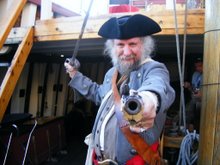A modern sailor's knife has a squared-off point but this is a fairly recent innovation. Knife-expert.com has an interesting quote.
Jim found a book called The Making of a Sailor, or Sea Life Aboard a Yankee Square-Rigger, by one Frederick Pease Harlow. The book was published in 1928, but recounts the author's experiences at sea as a boy about six decades earlier. On pages 90-93 Harlow describes the outset of a voyage to Melbourne, Australia. The first and second mates are choosing up the port and starboard watches for the voyage from the newly hired crew. The first mate, naturally, chooses first. "`I choose you... What's your name?' "`Hans, sir,' he replied. "`Let me have your knife,' requested the mate, who stood on top of the main hatch, with a hammer in his hand, which he was all the while turning and twisting. Upon receiving the sheath-knife, which is as much a part of sailor's uniform as his overalls and is always carried in a sheath or scabbard, hanging from a strap about the waist and back of the hips, where it is handy for cutting rope, for a sailor is not dressed without his knife, the mate put the point of the knife across the iron band on top of the combings of the hatch and struck a sharp blow with the hammer, breaking off the point. "`You probably didn't have the mate, in your last ship, break the point off your knife.' said Mr. Burris. `But I always keep a ship sweet and clean by seeing that every knife aboard the ship has no point. This is for your own protection. If you get into a fight with a shipmate you know you can't stick him with your knife or he, you. Knowing this you both will fight like men and use your fists, the weapons God has given you to fight with.' "Returning the knife to Hans, he was told to stand over to the port rail... "The second mate then chose Jim Dunn... His knife was broken in the same manner and he was told to stand over to the starboard rail... The selection and knife-breaking continued until the 14 men and two boys were all divided into two watches. "Going forward, I followed the men into the forecastle. A big Irishman by the name of O'Rourke, was much put out by having his knife point broken and was saying as I entered, `I don't know phat ye's fellers tink about it, an' I haven't been to sea for ten years, but fifteen years ago I sailed in the [Clipper] ships Live Yankee [built 1853, wrecked 1861] and the Phantom and if ships of that caliber can make a viage widout breakin' our knives, why in the... does an old tub like this wan want to do it?'"
It goes on to say that a law was passed in 1866 saying:
No seaman in the merchant service shall wear any sheath knife on shipboard. It shall be the duty of the master of any vessel registered, enrolled, or licensed under the laws of the United States, and of the person entering into contract for the employment of a seaman upon any such vessel, to inform every person offering to ship himself of the provisions of this section, and to require his compliance therewith, under a penalty of $50 for each omission...
This tells us that pointed knives were used prior to 1866. O'Rourke, who hadn't sailed for ten years, seemed to think it was standard to have a pointed knife.
Given this, and given the need for pirates to be well-armed, I doubt that anyone was breaking off the tips of pirates' knives 150 years before this law was passed.
That said, there is a practical reason for squaring off a sailor's knife. If the knife has a point, a sailor will inevitably use it to pick open knots, possibly damaging the rope in the process. If the point is removed, the sailor will have to use a rounded marlin spike instead.



